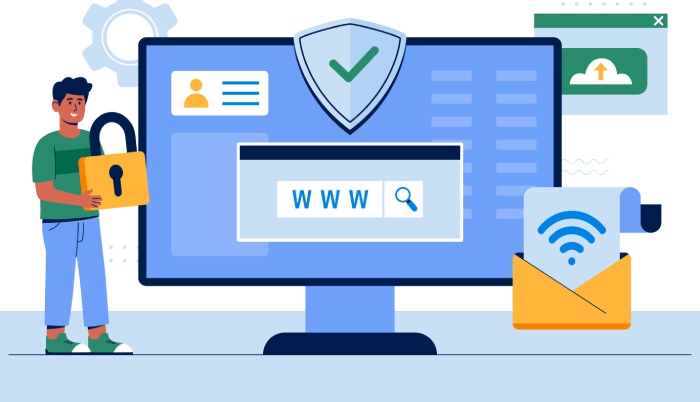DomainKeys Identified Mail (DKIM) stands as a crucial pillar of email authentication and security. Defined under RFC 6376, DKIM is an email protocol that uses cryptography to sign email messages with a private key after leaving the mail client or mail server, specifically the mail transfer agent (MTA). The cryptographic signature included in the email headers enables receiving mail servers to perform signature verification by retrieving the corresponding public key from a DNS TXT record associated with the sender’s email domain.
This process ensures that email messages are not altered in transit by applying a hashing algorithm—typically SHA-256—and encoding the signature in Base64. The public key is published in the DNS zone file as a TXT record with specific TXT record syntax, facilitating DNS lookups by recipient mail gateways. The use of a key selector during DNS lookup enables mail servers to identify the correct public key to validate against the private key signature.
DKIM’s importance lies in securing email infrastructure by enhancing email deliverability and protecting the sender’s email reputation. Email clients, spam filtering systems, and email gateways utilize DKIM alongside SPF (Sender Policy Framework) and DMARC (Domain-based Message Authentication, Reporting & Conformance) to verify authentication results. This layered defense significantly boosts phishing prevention, email spoofing mitigation, and overall mail flow integrity.
How DKIM Protects Your Email from Spoofing and Phishing
Email spoofing is a top vector for phishing attacks, where malicious actors forge the ‘From’ header in email headers to impersonate trusted domains. DKIM combats this threat by binding the digital signature using the sender’s private key, which only authorized mail servers can access. If an attacker tries to spoof the email domain, the signature verification will fail during DNS lookup since the forged email will lack a valid cryptographic signature corresponding to the public key published in DNS records.
By enforcing DKIM in conjunction with SPF and DMARC policies, organizations enable mail servers to validate the source and integrity of incoming emails. This combined email authentication framework dramatically improves phishing prevention efforts and minimizes fraudulent emails passing through email spam filtering systems and email gateways, such as those offered by Proofpoint, Mimecast, or Barracuda Networks.
Additionally, DKIM validation helps maintain email deliverability by avoiding the pitfalls of reverse DNS rejection or classification into spam folders. Through efficient use of cryptography, hashing algorithms, and DNS configurations, organizations can safeguard their email domains from complex phishing threats targeting their users and customers.
Overview of MxToolBox: A Trusted Tool for Email Security
MxToolBox is an industry-leading online platform specializing in email security diagnostics, DNS management, and email validation tools. Renowned for its comprehensive suite, MxToolBox supports DNS lookup, email protocol analysis, and DKIM signature testing to ensure organizations maintain robust email security postures.
With a user-friendly interface and integration capabilities with cloud email providers like Google Workspace and Microsoft 365, MxToolBox allows easy monitoring of mail flow and authentication results. Its DKIM generator simplifies creating the cryptographic keys and generating the TXT record syntax essential for publishing the public key in DNS zone files.
MxToolBox’s testing tools also enable in-depth email headers analysis and signature verification, allowing administrators to identify defects in their DKIM implementation and troubleshoot issues related to DNS propagation or mail server misconfigurations. MxToolBox complements other prominent email security platforms like DMARC Analyzer, Agari, Valimail, and Dmarcian by providing focused, accessible tools for email authentication management.
Step-by-Step Guide to Using the DKIM Generator on MxToolBox
The DKIM generator tool on MxToolBox simplifies the complicated task of generating a valid public/private key pair and crafting the necessary DNS TXT record to enable DomainKeys Identified Mail for your email domain.
Step 1: Access the DKIM Generator
Navigate to the MxToolBox DKIM generator page. This tool offers customization of key length and hashing algorithms, typically recommending a 1024 or 2048-bit RSA key with SHA-256 hashing to comply with RFC 6376 standards.
Step 2: Enter Your Email Domain and Key Selector
Input your registered email domain—whether for Google Workspace, Microsoft 365, or a custom mail server—and choose a key selector. The selector helps mail servers locate the correct public key during DNS lookup and is reflected in your DNS TXT record name (e.g., selector._domainkey.yourdomain.com).
Step 3: Generate the Key Pair
Upon submission, MxToolBox generates a private key for signing your outbound emails and a corresponding public key displayed in a format compatible with TXT record syntax. The public key is a hexadecimal key encoded in Base64 and designed for direct copy-pasting into your DNS records.
Step 4: Secure Your Private Key
Safeguard the private key since it will be used by your mail transfer agent or SMTP server to create cryptographic signatures for outgoing emails. Popular mail infrastructure software such as OpenDKIM supports seamless private key integration.
Step 5: Obtain the TXT Record for DNS Publishing
The tool provides the full TXT record corresponding to your DKIM public key, including the key selector and necessary tags like v=DKIM1; k=rsa; p= (the public key). This TXT record defines your email policy for recipients to authenticate your emails.
Configuring Your DNS with the DKIM Public Key from MxToolBox
Publishing the public key correctly in your DNS zone file is essential to enable recipients to perform signature verification and validate your DKIM signatures.
Step 1: Access Your DNS Management Console
Whether using DNS providers like Cloudflare or your corporate DNS management solution, log in to access your DNS records for your email domain.
Step 2: Add the DKIM TXT Record
Create a new TXT record in your DNS. The record’s name should follow the syntax:
`[selector]._domainkey.[yourdomain]`
where `[selector]` is the key selector you chose in the MxToolBox generator, and `[yourdomain]` is your email domain.
Paste the TXT record value generated by MxToolBox, including the full public key in Base64 and the appropriate DKIM tags.
Step 3: Save and Apply Changes
Save the TXT record entry. DNS propagation may take from a few minutes to several hours depending on your DNS provider’s TTL (Time To Live) settings and zone file configurations.
Step 4: Verify DNS Propagation and Record Accuracy
Use MxToolBox’s DKIM lookup or signature verification tools to perform a DNS lookup and confirm that the TXT record is visible and correctly formatted. This step is critical to avoid authentication failures affecting your email deliverability.
Step 5: Implement DKIM Signing on Your Mail Server
Configure your mail server or email service provider—such as SendGrid, Amazon SES, Postmark, Mailgun, or SparkPost—to use the generated private key for signing email headers with DKIM. This ensures your outbound messages are cryptographically signed in compliance with best practices.
By leveraging the DKIM generator and testing tools provided by MxToolBox, administrators of diverse email infrastructure can deploy stronger email authentication, improve email reputation, and significantly enhance phishing prevention and email security across their domains.
Testing Your DKIM Setup Using MxToolBox Tools
Ensuring the robustness of your DomainKeys Identified Mail (DKIM) configuration is a critical step in achieving reliable Email authentication and bolstering your Email security framework. MxToolBox offers a suite of diagnostic tools designed to validate your DKIM setup by performing DNS lookup operations focused on your DNS records, particularly the TXT record containing your cryptographic signature and public key.
To begin, enter your Email domain and the relevant Key selector into MxToolBox’s DKIM Lookup tool. This initiates a DNS lookup in the DNS zone file, retrieving your public key stored as a TXT record. The tool assesses the TXT record syntax against RFC 6376, which defines the DKIM standard, verifying the correct configuration of the hexadecimal key, hashing algorithm (typically SHA-256), and Base64 encoding. Additionally, the tool analyzes Email headers to validate signature verification processes, ensuring that the mail transfer agent, usually operating over SMTP, correctly appends the DKIM signature to outgoing messages.
MxToolBox’s interface also displays the Authentication results, providing insights on your DKIM’s impact on Email deliverability and filtering through common Email gateways and spam filtering mechanisms. Testing regularly during DNS propagation ensures your DNS management is up to date and consistent.
Troubleshooting Common DKIM Issues with MxToolBox
When facing issues like failed signature verification or inconsistent authentication results, MxToolBox serves as an indispensable resource for troubleshooting. A frequent cause is incorrect DNS zone file entries—specifically errors in the TXT record syntax. Ensure that your public key, private key, key selector, and hostname are correctly aligned and that the public key is properly Base64 encoded.
Another common problem arises from DNS propagation delays—changes made in DNS records can take time to disseminate, leading to temporary authentication failures. MxToolBox’s DNS propagation checker helps pinpoint these delays.
Issues with the mail server or mail transfer agent can also impede DKIM signature verification. Misconfigured SMTP servers may omit the DKIM header entirely or use an incorrect hashing algorithm other than SHA-256. In such cases, reviewing your Email infrastructure and consulting Mail server and mail client logs can uncover discrepancies. Analyzing Email headers with MxToolBox identifies missing or malformed signatures, Reverse DNS mismatches, or SPF conflicts that degrade Email reputation and impact phishing prevention.
For organizations utilizing cloud platforms like Google Workspace, Microsoft 365, or third-party Email services like Amazon SES, SendGrid, Postmark, or SparkPost, ensuring that DKIM keys are properly synchronized across mail flow components is essential. Tools provided by vendors such as OpenDKIM or services like EasyDMARC and DMARC Analyzer complement MxToolBox’s scans by offering deeper insights into Email policy enforcement.
Integrating DKIM with SPF and DMARC for Enhanced Email Protection
While DKIM validates that an Email domain owner has authorized a particular mail server to send messages through a cryptographic signature, combining it with Sender Policy Framework (SPF) and Domain-based Message Authentication, Reporting, and Conformance (DMARC) provides a comprehensive Email authentication strategy.
SPF works by publishing DNS TXT records listing authorized mail servers; during SMTP mail flow, receiving servers perform a DNS lookup to verify the sending IP against the domain’s SPF record. DMARC builds on both SPF and DKIM by enforcing Email policy and defining how receiving mail servers should handle messages failing authentication checks, reducing Email spoofing and phishing attempts significantly.
MxToolBox supports testing and validating SPF and DMARC records alongside DKIM, showing Authentication results and Email headers analysis to determine compliance with set policies. Integration with industry solutions—such as Proofpoint, Mimecast, Barracuda Networks, Cisco, Symantec, Agari, or Dmarcian—reinforces Email infrastructure and spam filtering capabilities through layered Email validation.
For companies using Email gateway products, the synergy of DKIM, SPF, and DMARC facilitates more accurate Email spam filtering and enhances Email reputation with major Mail clients and Internet Service Providers, promoting better Email deliverability.
Benefits of Regular DKIM Validation and Monitoring
Ongoing validation and monitoring of DKIM settings are vital to maintaining Email security in dynamic network environments. Periodic checks via MxToolBox or similar tools reveal discrepancies within DNS records that might result from inadvertent DNS zone file edits or key expiration.
Regular audits catch unauthorized changes to TXT record entries or private key exposure, both of which compromise the cryptographic signature integrity designed to prevent Email spoofing. Monitoring ensures continued compliance with RFC 6376 and confirms that the hashing algorithm used is secure, typically SHA-256.
Additionally, consistent DKIM validation supports overall Email reputation management by preventing Email spoofing and minimizing false positives in Email spam filtering. When combined with real-time analysis from DMARC Analyzer or Valimail, organizations gain granular insights into Email traffic patterns, aiding phishing prevention.
This proactive approach not only helps in signature verification but also strengthens Email deliverability rates and reduces threat vectors associated with compromised or malicious Email domains.
Best Practices for Maintaining Strong Email Security with MxToolBox
To maintain robust Email security, it is best practice to:
- Fully configure DKIM, SPF, and DMARC records with correct DNS TXT record syntax, ensuring seamless interoperability among Email authentication protocols.
- Use dedicated DKIM key selectors wisely, rotating private and public keys periodically to comply with cryptographic best practices and mitigate hacking risks.
- Leverage tools like MxToolBox for regular DNS lookup audits and Email headers analysis to verify signature authenticity and detect anomalous mail flow.
- Monitor DNS propagation timings carefully whenever DNS records are updated, particularly when changes involve Email infrastructure hosted on Cloudflare or similar DNS management platforms.
- Employ integrated Email gateways and spam filtering solutions from trusted providers such as Mimecast, Proofpoint, or Barracuda Networks to complement cryptographic Email validation efforts.
- Maintain comprehensive Email policy alignment and continuous Email validation for all sending sources, including third-party services like Mailgun and SendGrid, ensuring consistency in authentication results.
- Educate IT administrators on the importance of adhering to the Email protocol standards defined by RFC 6376 and on managing cryptographic elements such as private keys securely within the Email domain’s infrastructure.
By combining these best practices with the capabilities of MxToolBox and other leading industry tools, organizations can significantly enhance their protection against phishing and Email spoofing attacks, while ensuring optimal Email deliverability and reputation.
FAQs
What is the role of a DKIM key selector in Email authentication?
A key selector identifies which cryptographic public key to use for signature verification. It directs receiving mail servers to the correct DKIM TXT record in DNS, enabling accurate signature validation without confusion when multiple keys exist for a single domain.
How does DKIM complement SPF and DMARC in preventing Email spoofing?
DKIM provides a cryptographic signature proving message integrity from the purported sender. SPF specifies authorized servers by IP, and DMARC establishes how to handle messages failing these checks. Together, they create a fortified Email authentication framework to reduce spoofing and improve Email reputation.
Why is regular DKIM monitoring important?
Regular monitoring detects changes or errors in DNS TXT records, expired keys, or propagation issues, all of which could cause failed Email validation, leading to delivery problems and increased vulnerability to phishing and spoofing attacks.
Can MxToolBox test DKIM for cloud Email services like Google Workspace?
Yes, MxToolBox can perform DKIM lookups and validation for Email domains hosted on cloud platforms such as Google Workspace, Microsoft 365, and third-party providers like Amazon SES or SendGrid, ensuring proper DNS record setup and cryptographic signature accuracy.
What hashing algorithm is typically used in DKIM signatures?
The SHA-256 hashing algorithm is commonly used due to its balance of security and performance. It provides a secure cryptographic hash of the Email content during signature creation, as specified in RFC 6376.
Key Takeaways
- MxToolBox is a critical tool for validating and troubleshooting DKIM DNS TXT records, ensuring proper implementation of cryptographic signatures and key selectors.
- Integrating DKIM with SPF and DMARC protocols forms a multi-layered defense against Email spoofing, phishing, and reputation degradation.
- Regular monitoring of DKIM configuration, including signature verification and DNS zone file management, is essential for maintaining Email deliverability and security compliance.
- Adhering to Email authentication standards like RFC 6376 and using trusted Email security providers enhances protection against malicious Email campaigns.
- Combining technical tools and Email policy enforcement with continuous Email headers analysis allows organizations to optimize their Email infrastructure for enhanced spam filtering and phishing prevention.





